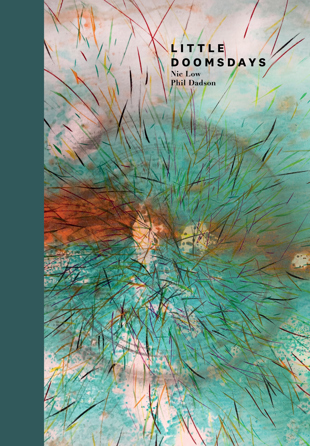Little Doomsdays by Nic Low and Phil Dadson has been reviewed in Aotearoa New Zealand Review of Books. It’s the fifth in the kōrero series edited by Lloyd Jones. Reviewer Ian Wedde says:
I’m happy to say early that this is one of the most engaging, inventive and original sequences of writing I’ve read in a long time, so congratulations to Nic Low; and to Phil Dadson for his companion graphic work, which navigates variations whose narrative weightings and discourse relationships with the text are subtle, beginning with the book’s front cover — which I’ll return to disingenuously in a while, having read on past it.
The core conceit or concept of the book is “arks”, varieties of repositories, stores and archives designed to withstand and outlive catastrophes and even just the passing of time — listed in the book’s opening section as including “waka huia, time capsules, caches, burial ships, seed banks, languages, objects and data”. In this account, set in the post-apocalypse future, the overarching or collating “ark” in an ambitious quest for global summary was what became known as the “Ark of Arks”, created “in the late twentieth century” by “an unstable grouping of scholars, writers and fanatics from several Ngāi Tahu hapū in Murihiku”.
The Ark of Arks, “compiled immediately before the last flood”, aimed “to catalogue all known arks from the last five millennia”. The scholars ‘gathered their knowledge onto a dozen hard drives and placed them inside a lead-lined stainless-steel waka huia’. We, the readers of the future who have rediscovered the waka huia in the “Ark of Arks”, have powered up the screens contained in the ark. “You have found the Ark of Arks. You are reading it now.”
We post-apocalypse survivor-readers will find ourselves at, for example, “Item 08FDS08S-SF808F: Icarda Dry Area Crop Store, 2012 CE”. We are in Aleppo, in Syria, “among the oldest continuously inhabited cities in the world”. If we dig down past the cobbles of Mousslama Ben Abdel Malek Street we’ll unearth “an earthen time capsule demonstrating how different civilisations will love the same place” — French, Ottoman, Mongol, early Islamic, Roman, Byzantine, Seleucid folk, to “nomads who camped nearby 11,000 years ago”. “Old Abraham” used to milk his sheep nearby.
The “Item” heading directs us to the nearby seedbank of The International Centre for Agricultural Research in the Dry Areas (ICARDA) which would have contained “the wild matriarchs of today’s crops, dating back to where “the domestication of crops began”. Members of the Free Syrian Army resisting the Assad regime in 2012 found themselves holed up in the ICARDA centre. There, being short of food, the soldiers cooked up “a bowl of strange, bitter-tasting chickpeas”.’
Read the full review here.


